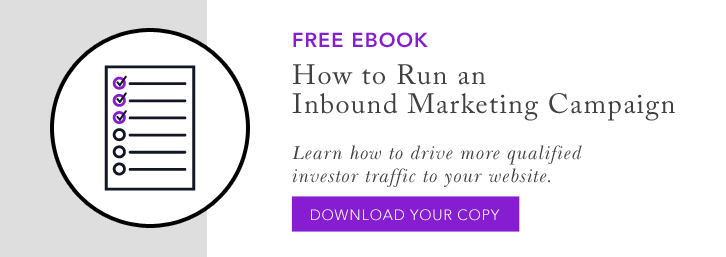Breakaway Broker Series: 10 Ways to Build Your Financial Planning Business Using the Internet
The big wirehouses are spending millions – even billions – on marketing. But plenty of small, independent planners and Registered Investment Advisors (RIAs) are still able to break through and have great success despite intense competition from the larger firms. For breakaway brokers, the Internet is a powerful tool that will give them a chance in the fight.
When breaking away, an advisor cannot rely on old Outbound Marketing techniques they remember from when they may have started in the field. These tactics, like cold calling, cold email campaigns and direct mail, are delivering less and less Return On Investment (ROI). Inbound Marketing techniques, on the other hand, including content marketing, social media and the like, are in the ascendency.
Here are 10 ways every advisor, especially a breakaway broker, should use the Internet to grow their business:
1. Start a blog.
According to online marketing and SEO expert Jayson DeMers, businesses that make blogging a priority see an ROI increase of 13 times year-over-year. Furthermore, according to Hubspot, businesses with 401 to 1,000 pages of content generate 48 percent more leads than businesses with between 51 and 100 pages.
Remember, if writing isn’t your thing, you don’t have to do all this writing yourself. In fact, you probably shouldn’t. Most successful planners outsource this type of work to professional copywriters like those at Paladin Digital Marketing who specialize in financial services. This way, these planners can focus their time on contacting prospects and serving clients – as it should be!
2. Blog early; blog often.
A 2017 report from Hubspot shows that firms that update their blogs at least 16 times per month generate 4.5 times more leads than firms that update their blogs five times per month or less. This is because frequent blog updates create regular, loyal users, and Google ranks new content higher than old content, all other things being equal. Interestingly, the smaller the firm size, the more ROI increase they tend to see when they ramp up their blogging and content generation efforts.
Increasing the number of blog posts from three or four per month to six or up to eight times per month is associated with a near doubling in the number of leads. Companies that blog just one to two times per month generate 70 percent more leads than companies that don’t blog at all.
Remember, repurposing content can be a great way to stretch your dollar. Using fresh content in another format may still rank it as original, unpublished content.
Creating fresh, relevant content for your website or blog can be a challenge. Say goodbye to writer's block! Download our free eBook: 5 Ways to Source Content for Your Financial Advisor Blog and Website
3. Get quality sites to link to you.
Google rewards businesses that have stellar reputations within their industries. Among the chief ways Google identifies businesses with great reputations is by counting the number of times recognized, high-quality sources link to them. If reputable news organizations, trade associations and academic sources link to your site regularly, your content will climb up the search rankings.
The best way to get them to link to you over time, of course, is great content, and lots of it. That takes effort, but it’s worth it.
4. Link to quality sites.
Search engines don’t just look at your inbound links; they look at your outbound links, too. The better your outbound links, the higher your own content will tend to rank. So, when you post blog entries, be generous with your hyperlinking. Cite everything you can with hyperlinks to leading industry websites – especially reputable news sources and the top bloggers in your industry.
5. Make a great first impression.
A bad first three seconds can cost you a lifetime of customer sales. A 2012 study from the Missouri University of Science and Technology found that it takes just 0.2 seconds for readers to form an initial impression of a website, and just 2.6 seconds for the eyes to take in a critical area of the website. They then spend an average of just 180 milliseconds to determine if it’s worth continuing to explore.
With that said, it’s critical to keep your landing pages clean, uncluttered, fast and focused on the most relevant and engaging content.
6. Engage on social media.
Research from BrandFog indicates that 82 percent of consumers are more likely to trust a company whose leadership team is active on social media websites. Social media also provides another way to network and connect with potential clients. You can repost your blog articles on Facebook, promote events on Twitter and connect with other people in your field on LinkedIn. Many of these opportunities are free, which is another huge benefit to breakaway brokers just getting started on their own.
7. Create a “lead magnet.”
A lead magnet is anything you can trade for contact information and the right to contact a prospect going forward. The idea is to provide something of value to a visitor and turn the visitor into a prospect.
On the Internet, this lead magnet, sometimes called a “freemium,” often takes the following forms:
- Complimentary eBooks
- White papers
- Cheat sheets
- Checklists
- “Tool kits”
- Planning kits
- Newsletter subscriptions
- Survey results and reports
- Tips and best practices
- Access to exclusive content somewhere on your website
- Membership in a discussion board or community
- Anything else you can devise
Once you have developed your freemium, it costs nothing to let a reader download it. In return, you have a willing, live, qualified lead. And you know what they’re interested in, based on what they’ve chosen to download. That gives you some intelligence on what products, services and benefits you should emphasize as you create an automated drip marketing campaign designed to turn prospects into clients.
8. Partner with a Digital Marketing firm that specializes in financial services.
You don’t need to reinvent the wheel. While generalist Digital Marketing firms have a hard time keeping up with the unique requirements of marketing within the financial planning business, a Digital Marketing firm that specializes in your industry can help you outsource non-core activities to genuine subject matter experts. This frees you up to do what you do best: Meet with prospects and serve your clients.
9. Get (good) reviews.
More than 90 percent of new clients will research you on the Web before they agree to an appointment with you. Most of them will look at review sites to see what other clients say about you. Get ahead of this process: Call your best clients and ask them if they would be willing to write a review for you on Yelp, Google and other relevant review sites. They should be eager to do it.
If they hesitate even slightly, this is a great opportunity for you to find out why – so you can fix the problem.
10. Engage via mobile devices.
Research from Google finds that people spend an average of 15 hours per week on their mobile devices. At a minimum, ensure your website is mobile-friendly. Google boosts search results for mobile-friendly sites. You can also design your own branded apps that make it easier for your clients to interact with you – and for you to engage with your clients. This process is already well underway in the real estate industry.
Companies like Paladin Digital Marketing can provide all of these services for you. Remember, Inbound Marketing isn’t an expense; it is your best source for new revenue.


